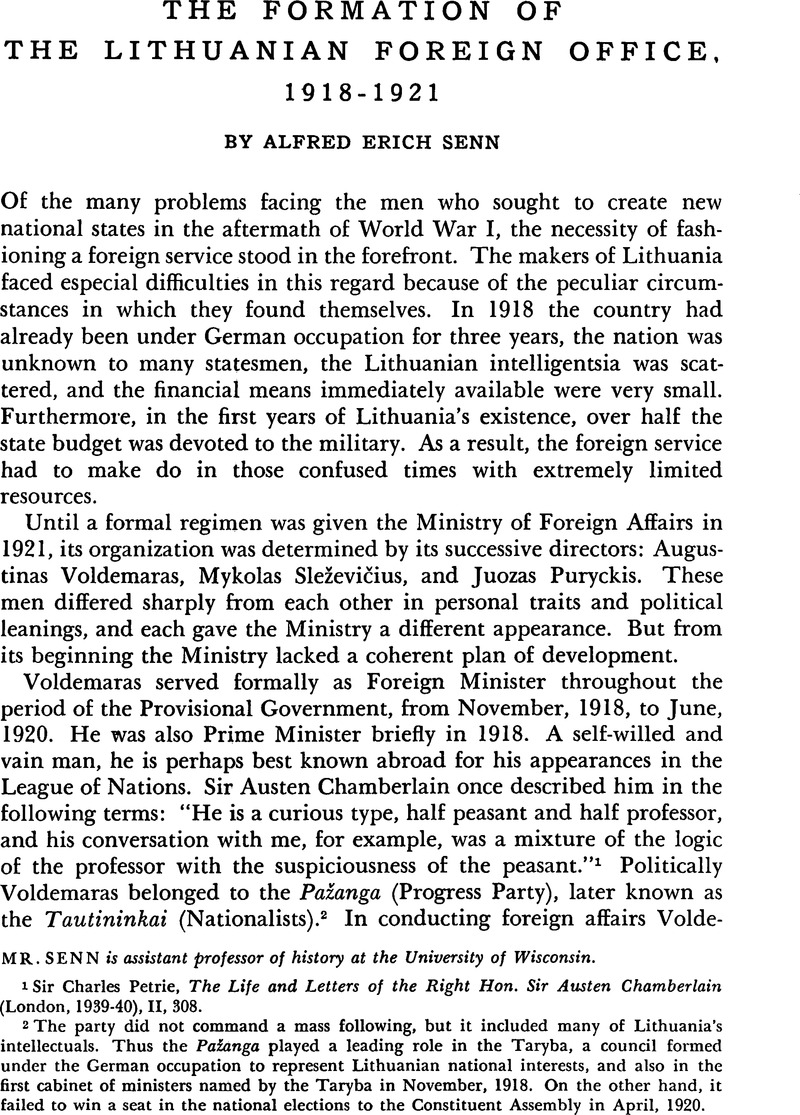Article contents
The Formation of the Lithuanian Foreign Office, 1918-1921
Published online by Cambridge University Press: 27 January 2017
Abstract

- Type
- Notes and Comment
- Information
- Copyright
- Copyright © Association for Slavic, East European, and Eurasian Studies. 1962
References
1 Sir Petrie, Charles, The Life and Letters of the Right Hon. Sir Austen Chamberlain (London, 1939-40), II, 308.Google Scholar
2 The party did not command a mass following, but it included many of Lithuania's intellectuals. Thus the Paianga played a leading role in the Taryba, a council formed under the German occupation to represent Lithuanian national interests, and also in the first cabinet of ministers named by the Taryba in November, 1918. On the other hand, it failed to win a seat in the national elections to the Constituent Assembly in April, 1920.
3 See Senn, Alfred Erich, The Emergence of Modern Lithuania (New York, 1959), pp. 45–46,51-55,85-86.Google Scholar
4 M. Sleževičius to J. Saulys, letter of January 7, 1919, cited in R. Šarmaitis, ![]() , No. 45 (1954), p. 268.
, No. 45 (1954), p. 268.
5 Šaulys was the government's chief trouble-shooter in its early months. After the governmental crisis was resolved, he was sent to Warsaw to conduct the first official talks between the Poles and the Lithuanians. In June, 1919, he was named to head Lithuania's iirst mission to the United States, but he became ill and could not go. Saulys had studied for several years in Switzerland before the World War, and during the war he had become very active in Lithuanian politics in Vilna.
6 Gabrys’ story can be found in his memoirs, Vers I'independance lituanienne (Lausanne, 1920).
7 The delegation was financed by the American Lithuanians, and secretarial help, as well as supplies such as typewriters, came from America.
8 These archives, extremely rich in materials for the whole interwar period, are held by the Library of the University of Pennsylvania, Philadelphia.
9 “The Council of Ministers would deliberate the question, make a decision, and the head of the Foreign Ministry, having summoned the selected delegates, would say, ‘Well, men, so and so—do what you can.’ “ V. O. Širvydas, Bronius Kazys Balutis: Jo gyvenimas ir darbai (Sodus, Michigan, 1951), pp. 69-70.
10 See J. Marcinkevičms, ![]() (Vilna), No. 1,1961, p. 29.
(Vilna), No. 1,1961, p. 29.
11 See Širvydas, op. cit., passim. This extremely interesting biography is perhaps the best single source on the Foreign Ministry in the years covered in this article.
12 Before 1914 Naruševičius had been an engineer in Moscow. Sent to the United States during the war, he decided to remain, and then in 1919 he went to Paris as a representative of the American Lithuanians.
13 The post eventually went to Vaclovas Sidzikauskas in June, 1922. Sidzikauskas, as a student in Switzerland, had been drawn into the Lithuanian mission there. In late 1919 he took over as chief of the mission and subsequently came to represent Lithuania in the League of Nations. Even after he went to Berlin, he continued as a delegate to the League, i*
14 Details in A. Merkys, ed., Lietuvos Istatymai (Kaunas, 1922), pp. 87-97.
- 1
- Cited by




